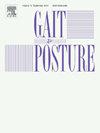In vivo ankle kinetics after surgical management of concurrent chronic ankle instability and osteochondral lesions of the talus
IF 2.2
3区 医学
Q3 NEUROSCIENCES
引用次数: 0
Abstract
Background
Ankle joint moment and reaction force alteration after surgical treatment of chronic ankle instability (CAI) and osteochondral lesions of the talus (OLT) remains unknown.
Research question
The current study aimed to investigate the in vivo kinetic effects of surgical management on patients with CAI and OLT and conduct a comparison with healthy subjects.
Methods
Eight patients with concurrent CAI and OLT were assessed in a stair descent setting prior to surgical management and one-year postoperatively. For inverse dynamic analysis, ground reaction forces and trajectories of skin markers were imported to AnyBody Modelling System to calculate the ankle joint reaction force and external ankle moment. One-dimensional statistical parametric mapping was performed for the comparison of ankle kinetic curves during gait cycle among healthy subjects, patients before surgery and patients after surgery.
Results
Preoperative patients displayed increased dorsiflexion moment compared with healthy subjects during 38.2 %–40.9 % of the gait cycle and during 38.1 %–41.1 % of the gait cycle with postoperative patients. Preoperative patients showed an increased anterior shear force compared with healthy subjects during 42.2 %–43.7 % of the gait cycle, and 42.8 %–43.2 % of the gait cycle with postoperative patients. Patients exhibited an increased maximal medial force preoperatively and postoperatively compared with healthy subjects (p < 0.001).
Significance
One-stage surgical treatment of CAI and OLT can decrease the excessive dorsiflexion moment and anterior force of the ankle joint. Excessive medial force of the ankle joint was partially decreased postoperatively, but it still significantly increased compared with that of healthy subjects. Such a finding may be attributed to impaired peroneal activation and requires additional rehabilitative treatment.
手术治疗并发慢性踝关节不稳定和距骨软骨病变后的体内踝关节动力学。
背景:手术治疗慢性踝关节不稳(CAI)和距骨软骨病变(OLT)后踝关节力矩和反作用力的改变尚不清楚。研究问题:本研究旨在探讨手术处理对CAI和OLT患者体内动力学的影响,并与健康受试者进行比较。方法:对8例同时行CAI和OLT的患者进行手术前和术后1年的楼梯下行评估。在逆动力学分析中,将地面反作用力和皮肤标记物的运动轨迹导入到任何人建模系统中,计算踝关节反作用力和踝关节外力矩。采用一维统计参数映射法比较健康受试者、术前患者和术后患者在步态周期中的踝关节动力学曲线。结果:术前患者在38.2 %-40.9 %的步态周期内和术后患者在38.1 %-41.1 %的步态周期内,与健康受试者相比,背曲力矩增加。术前患者在42.2% %- 43.7% %的步态周期和术后患者在42.8% %- 43.2% %的步态周期内,与健康受试者相比,前切力增加。与健康者相比,患者术前和术后最大内侧力均有所增加(p )。意义:CAI和OLT一期手术治疗可减少踝关节过度背屈力矩和前用力。术后踝关节内侧力过大虽部分减轻,但与健康者相比仍明显增加。这种发现可能归因于腓骨激活受损,需要额外的康复治疗。
本文章由计算机程序翻译,如有差异,请以英文原文为准。
求助全文
约1分钟内获得全文
求助全文
来源期刊

Gait & posture
医学-神经科学
CiteScore
4.70
自引率
12.50%
发文量
616
审稿时长
6 months
期刊介绍:
Gait & Posture is a vehicle for the publication of up-to-date basic and clinical research on all aspects of locomotion and balance.
The topics covered include: Techniques for the measurement of gait and posture, and the standardization of results presentation; Studies of normal and pathological gait; Treatment of gait and postural abnormalities; Biomechanical and theoretical approaches to gait and posture; Mathematical models of joint and muscle mechanics; Neurological and musculoskeletal function in gait and posture; The evolution of upright posture and bipedal locomotion; Adaptations of carrying loads, walking on uneven surfaces, climbing stairs etc; spinal biomechanics only if they are directly related to gait and/or posture and are of general interest to our readers; The effect of aging and development on gait and posture; Psychological and cultural aspects of gait; Patient education.
 求助内容:
求助内容: 应助结果提醒方式:
应助结果提醒方式:


